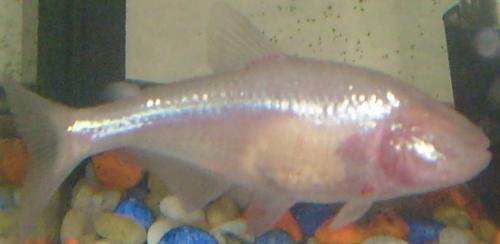Eyeless Mexican cavefish eliminate circadian rhythm to save energy

Eyeless Mexican cavefish show no metabolic circadian rhythm in either light and dark or constant dark conditions, according to a study published September 24, 2014 in the open-access journal PLOS ONE by Damian Moran from Lund University, Sweden, and colleagues.
The Mexican tetra fish has two variants, a fully-eyed fish living close to the surface and a blind, deep water, cave-dwelling fish. Scientists in this study used these two fish to study evolutionary adaptation in fish residing in near or total darkness. The two fish types experience differences in daily light exposure, food availability, and predation, which all may influence adaptation. The authors explored these evolutionary differences in laboratory-based experiments by measuring metabolic rate (oxygen consumption) of both Pachón cave and surface fish at a fixed swimming speed under light and dark and constant dark photoperiods.
Researchers found that the eyeless cavefish use ~30% less energy than surface fish, depending on lighting conditions. Surface fish displayed a circadian rhythm in oxygen consumption on a light-dark cycle, and they found that this metabolic rhythm persists even in constant darkness. Cavefish, however, show no circadian rhythm in metabolism, in either light-dark or constant dark conditions. The authors propose that this loss of a circadian rhythm enables cavefish to save energy. The authors suggest that elimination of the circadian rhythm in metabolism could be a general feature of animals that live in perpetually dark, food-limited environments, such as caves or the deep sea.
Damian Moran added: "While animals that live on the planet's surface need autonomous circadian rhythms to tune their physiology to their daily activities, the results of our study show that animals that live in environments without 24 hour cycles can save energy by not ramping up their metabolism needlessly for a day that will never arrive."
More information: Moran D, Softley R, Warrant EJ (2014) Eyeless Mexican Cavefish Save Energy by Eliminating the Circadian Rhythm in Metabolism. PLOS ONE 9(9): e107877. DOI: 10.1371/journal.pone.0107877
Journal information: PLoS ONE
Provided by Public Library of Science

















